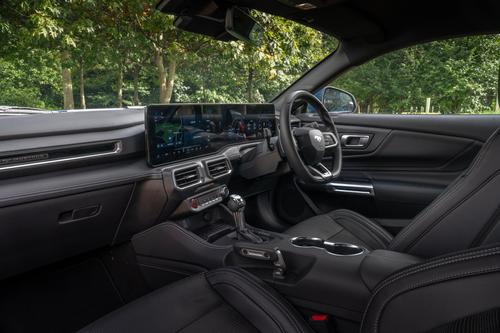
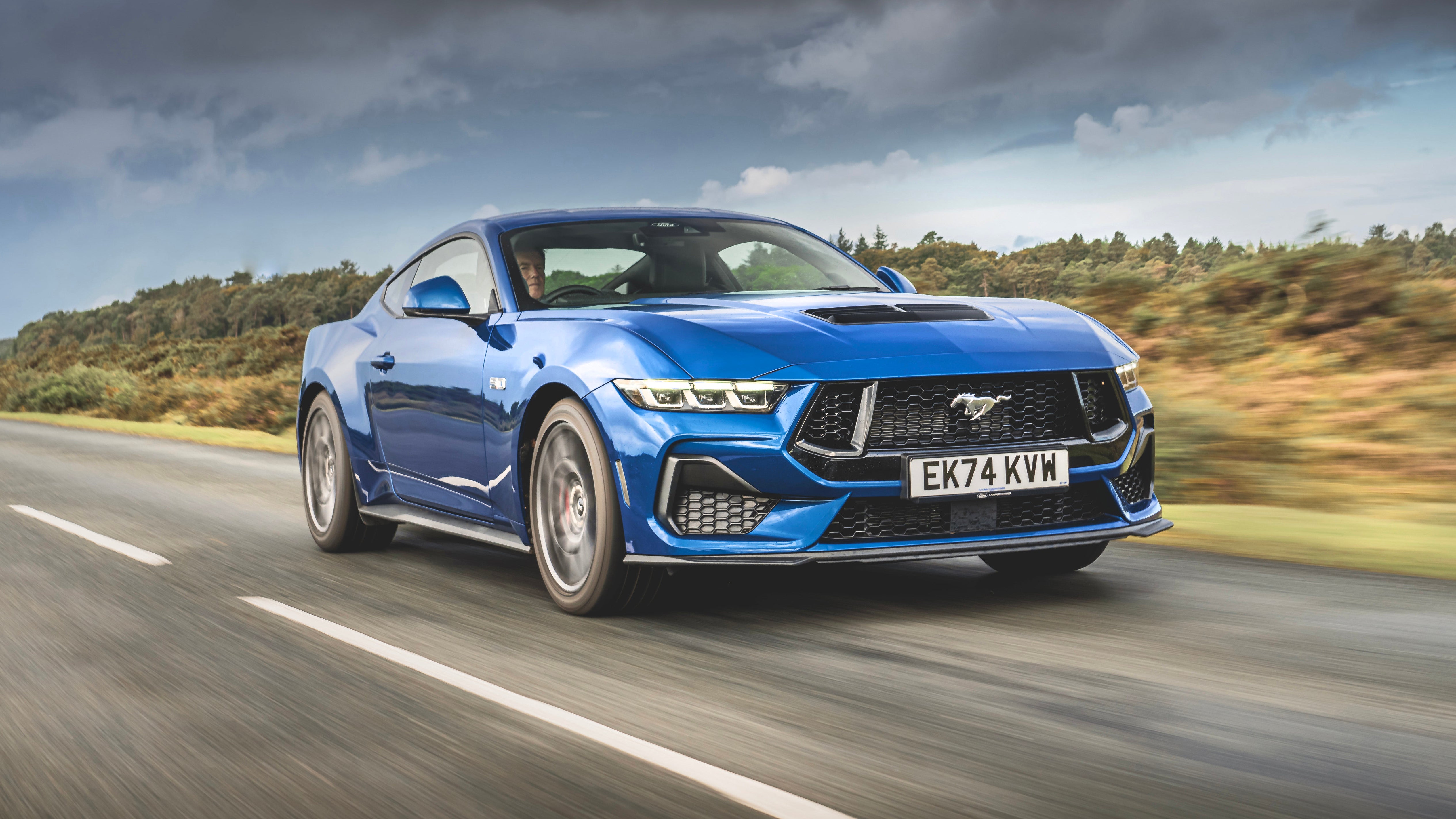

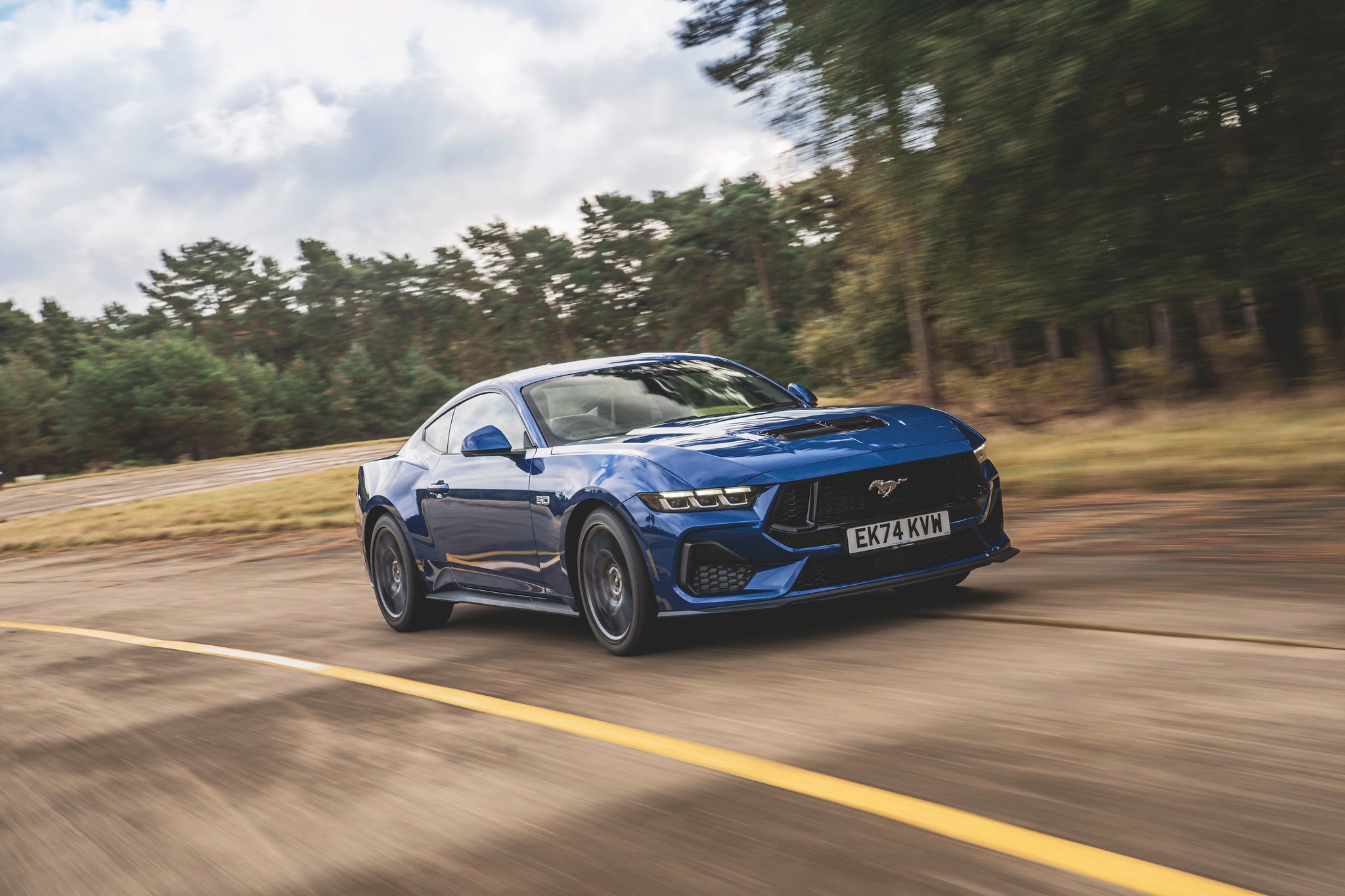
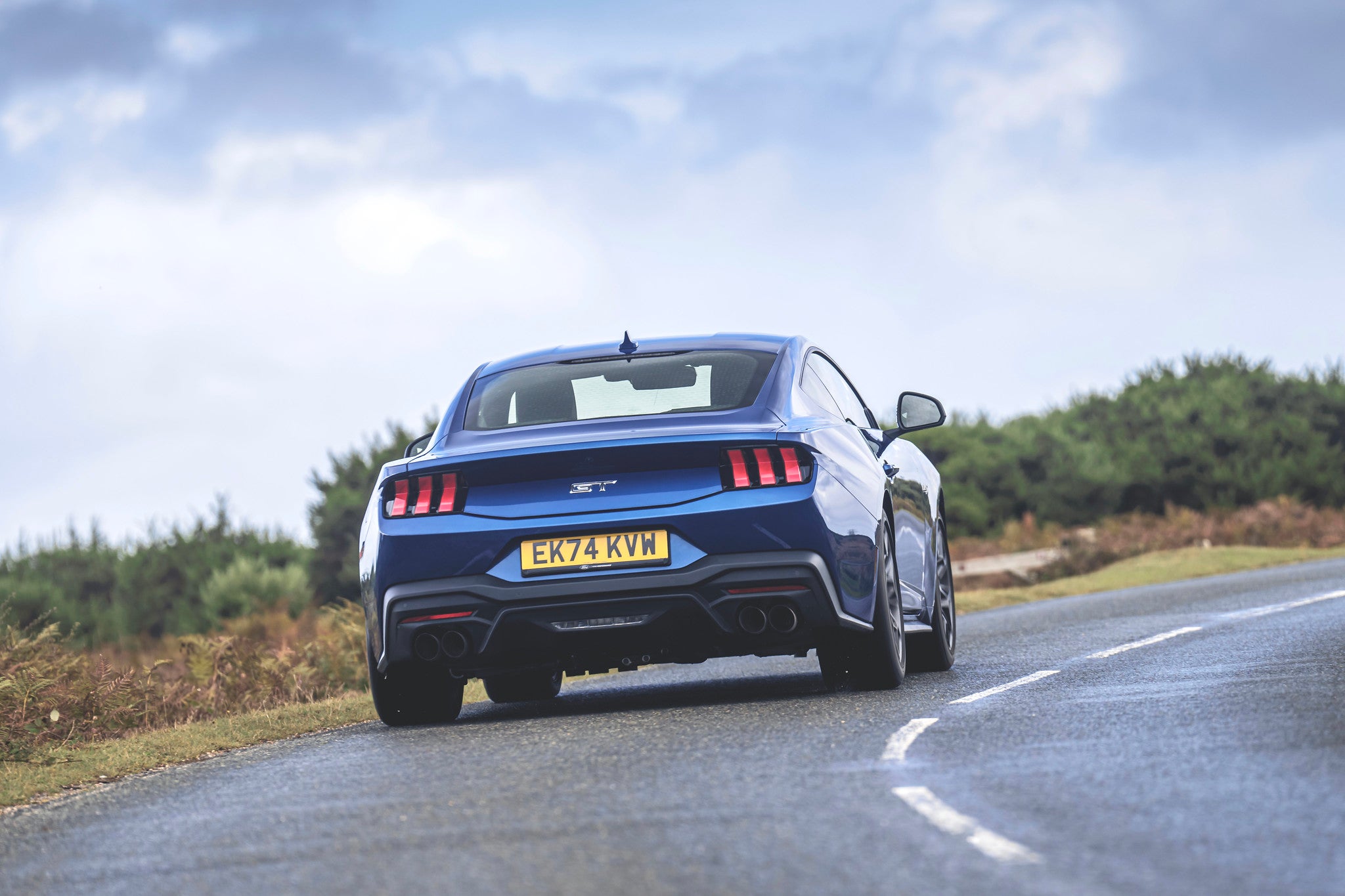
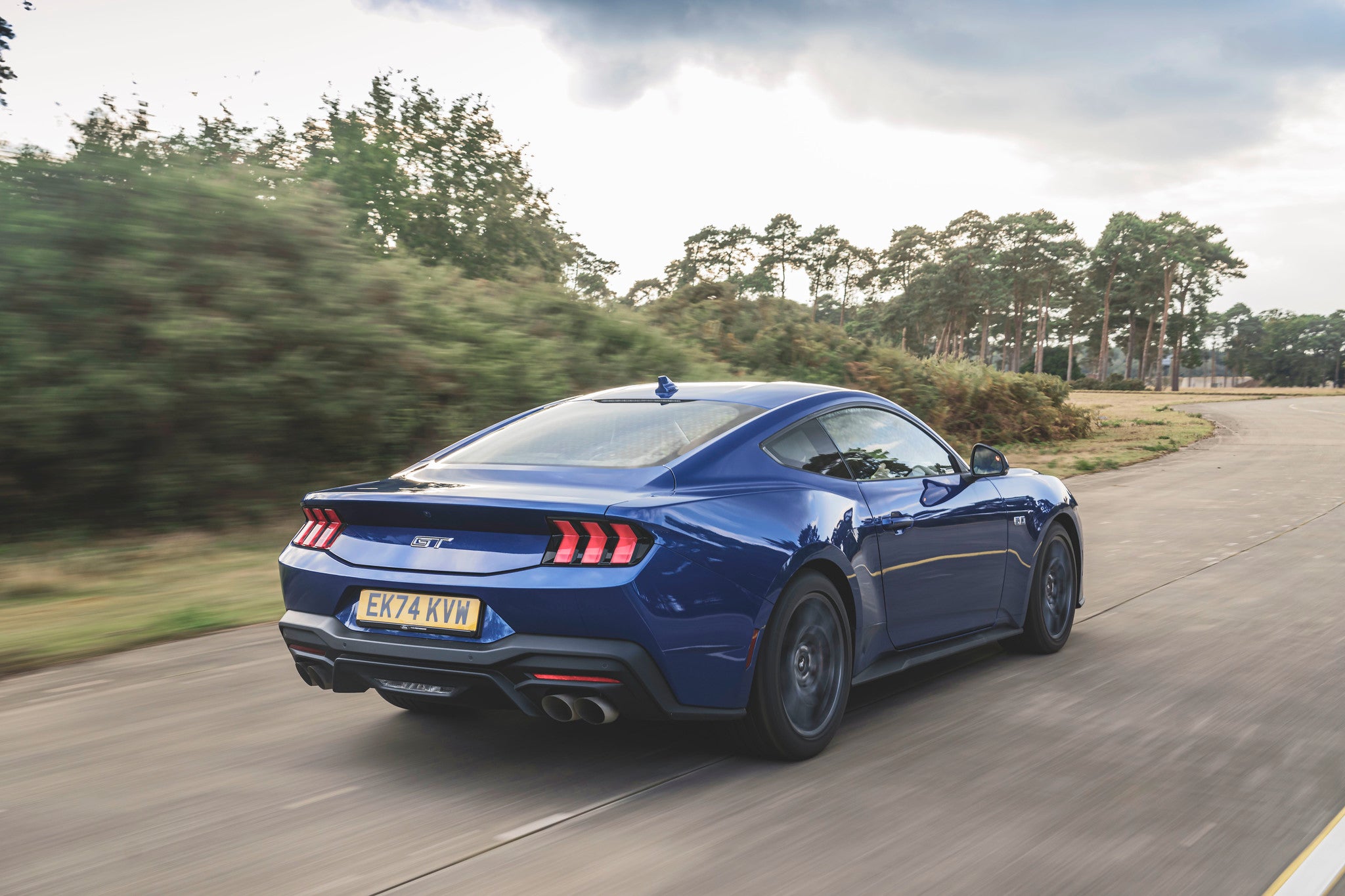
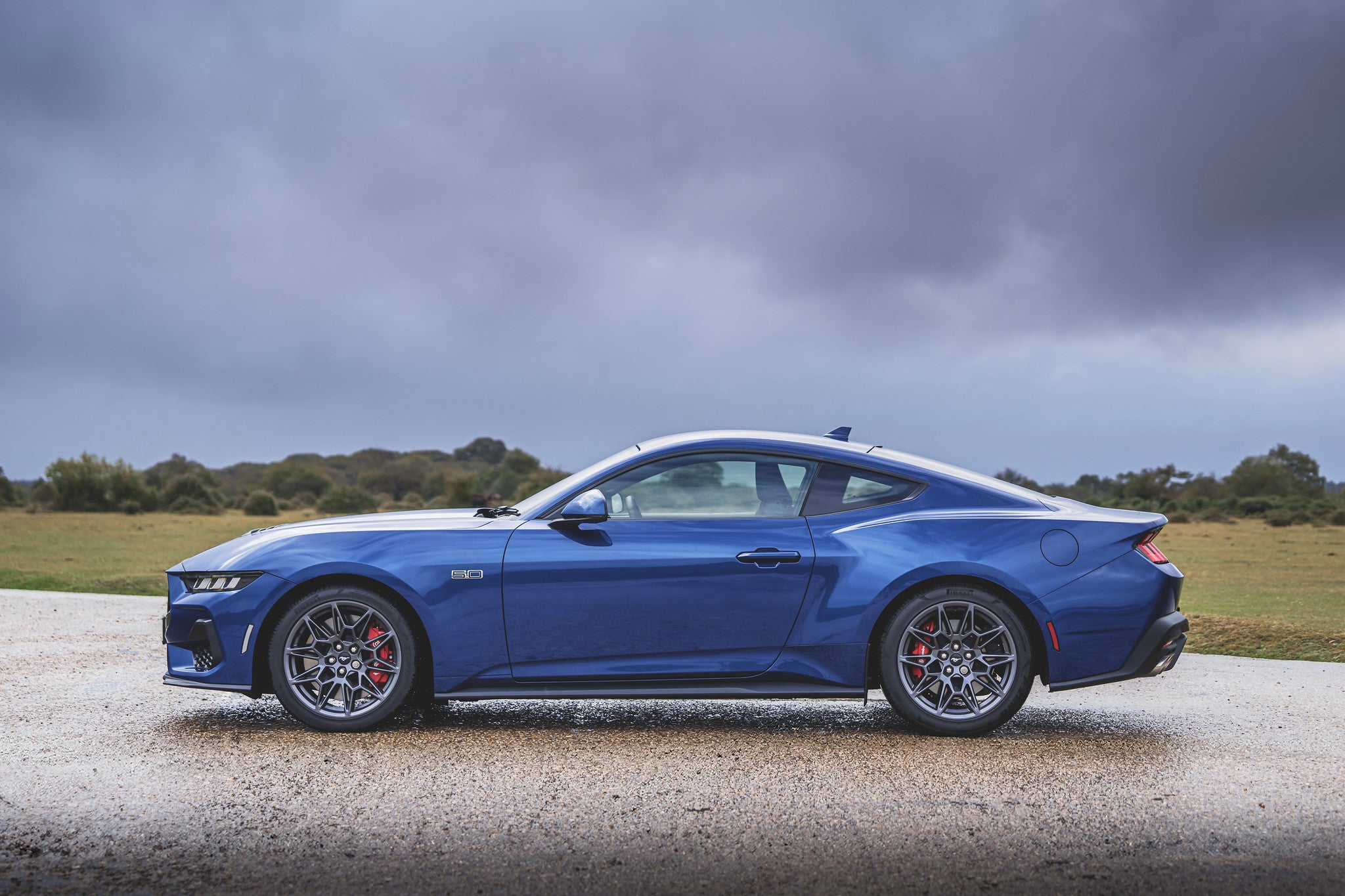

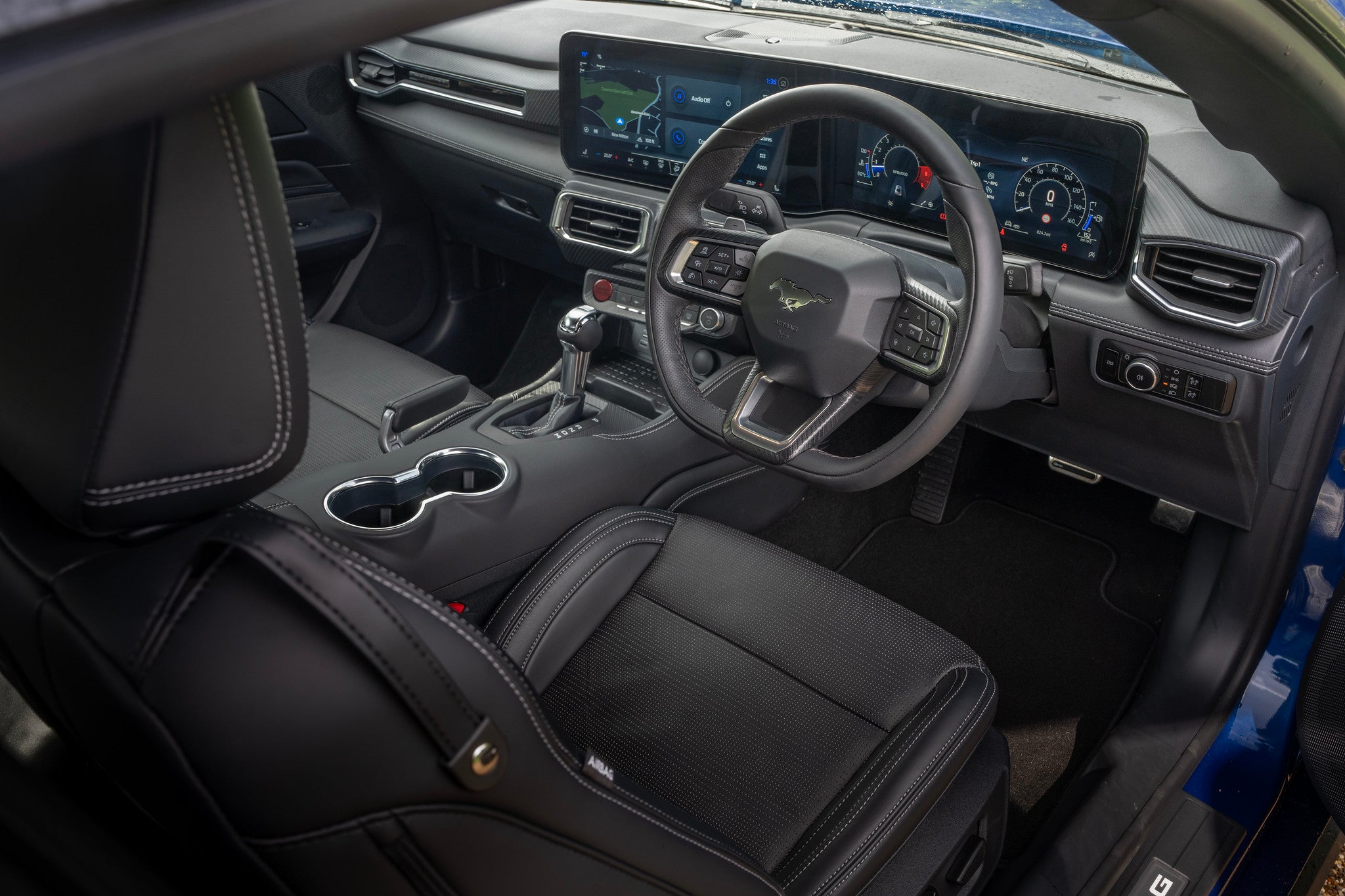



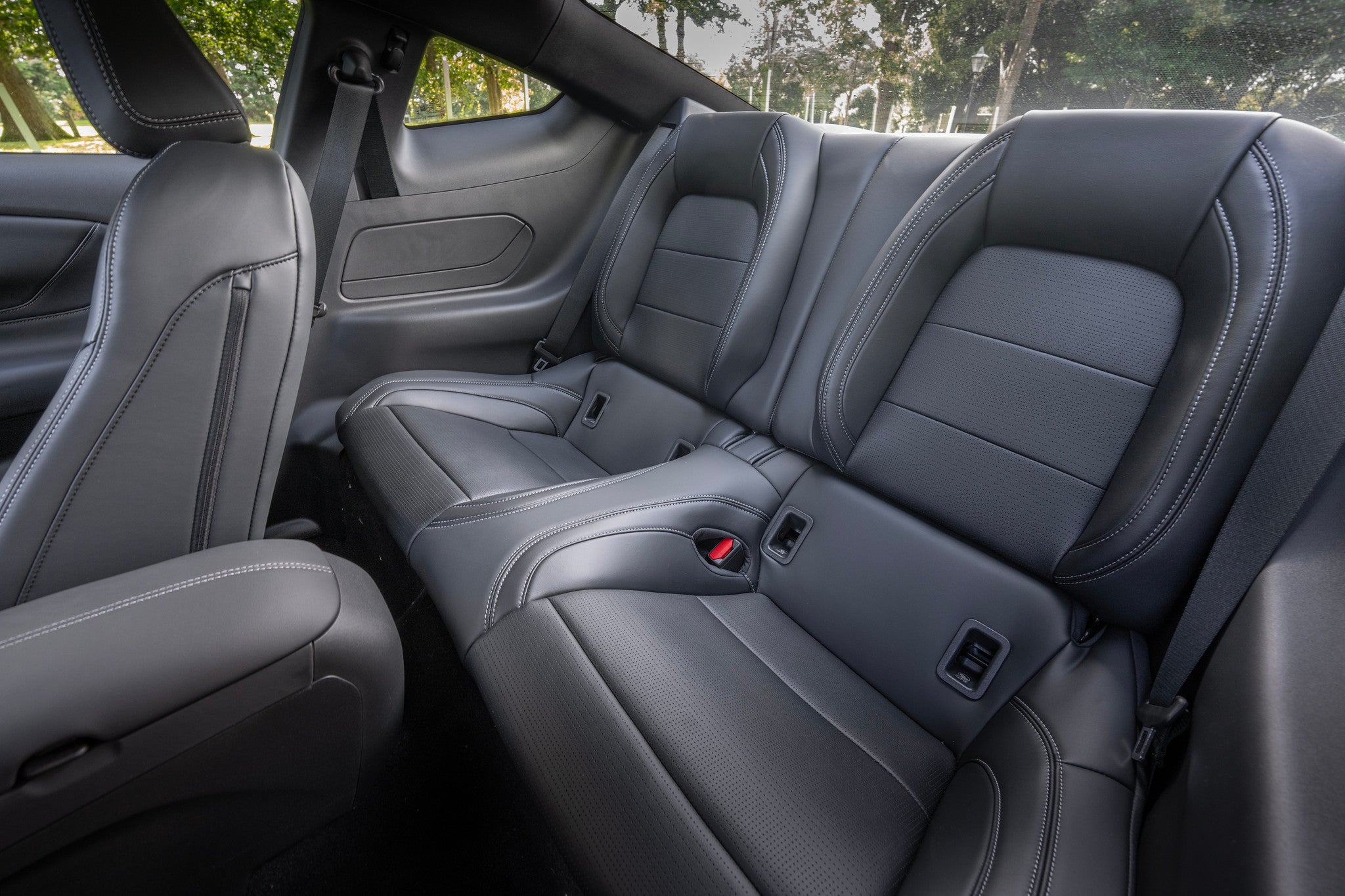
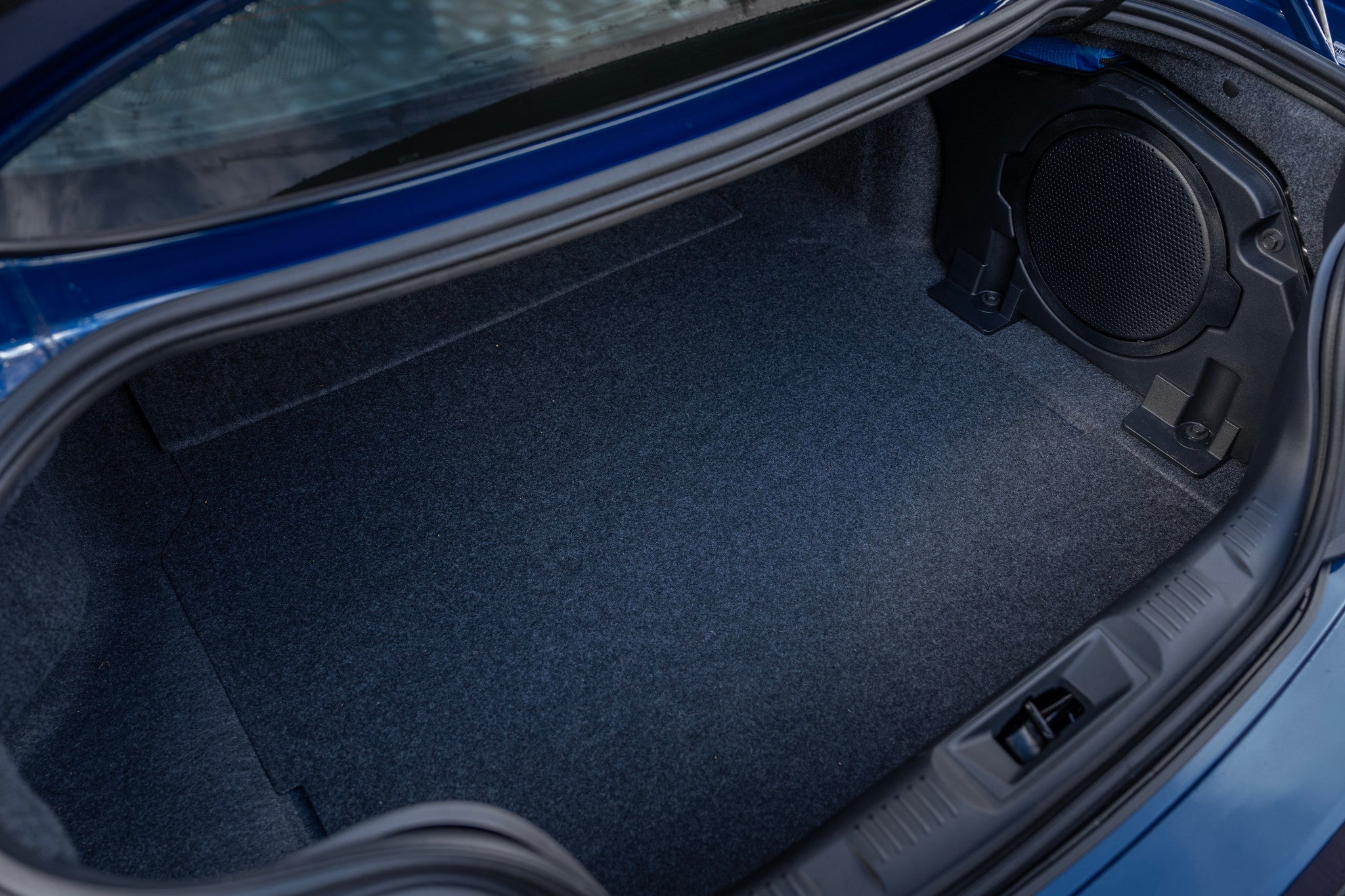
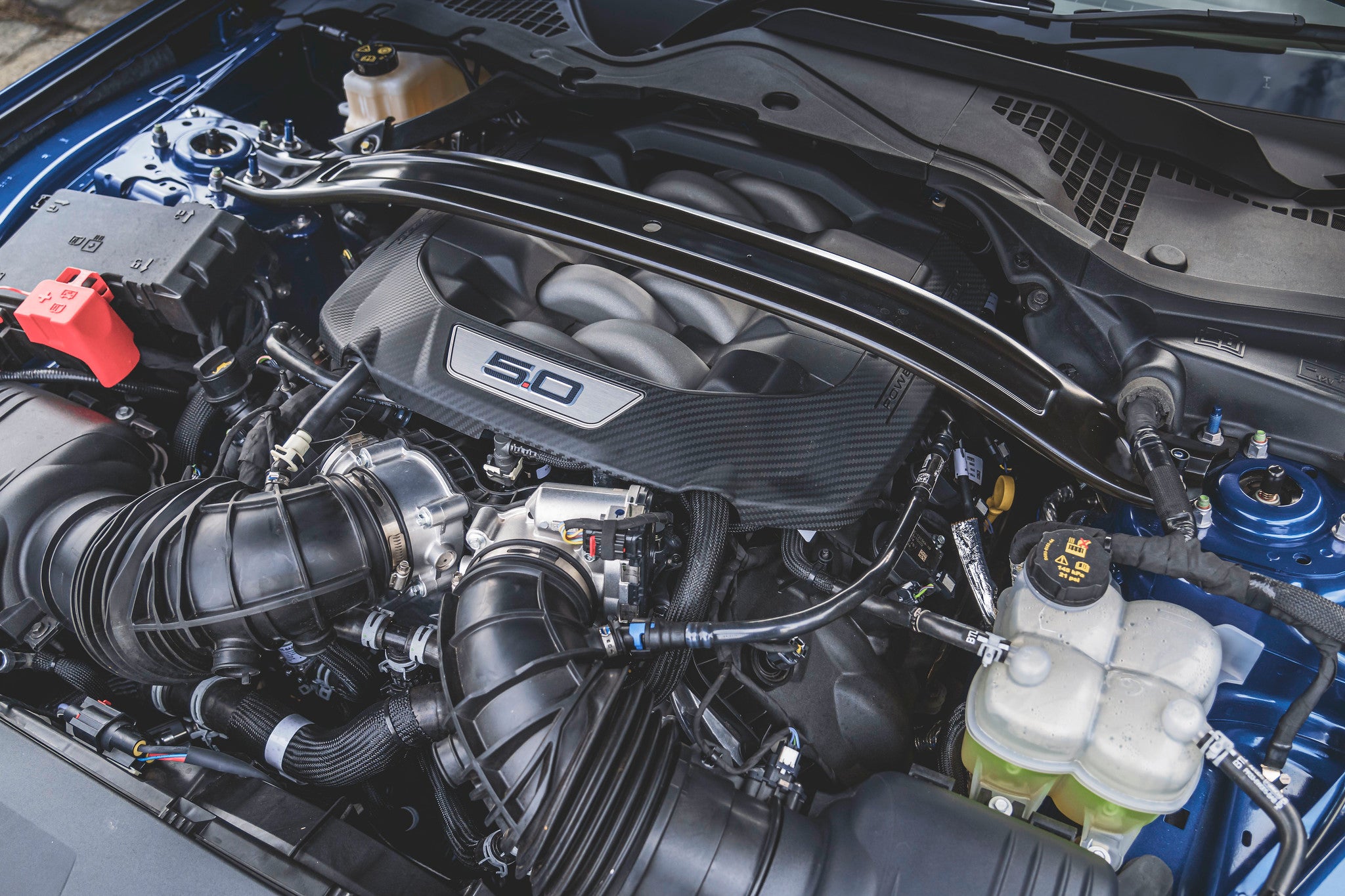
Ford Mustang Review

The latest version of the Ford Mustang is high-tech inside and deliciously old-school under the bonnet.
You now get one choice of engine, and it's the right one: a 5.0-litre V8. The interior's had a complete redesign with more premium materials and modern tech than the previous-generation car, but the driving experience is still a tad antiquated, and not for the faint-hearted.
- Sounds epic
- Strong straight-line performance
- A modern interior!
- Tricky to drive fast
- Feels long on UK roads
- Fuel economy…
Should I buy a Ford Mustang?
If you want a Mustang, buy a Mustang. Nothing else delivers anything like the same characterful V8-powered driving experience on UK roads. It's not perfect dynamically, and it can feel wayward on bumpy roads even on a light throttle. Put your foot to the floor and you best be paying attention – this still feels like a wild hot rod that can easily lead you into temptation… or a ditch.
That said, this latest generation Mustang does feel slightly more on your side than the previous car, but it's still nowhere near as satisfying or reassuring to drive quickly as a (now similarly priced…) Porsche 718 Cayman or a BMW M2.
This 2025 Mustang gets a strong new look, despite using many of the old car's components underneath the skin. For about £10,000 over the basic list price you can upgrade to a Dark Horse model, which has different wheels, matt-grey decals on the bonnet, a large fixed rear spoiler, a snappier Tremec manual gearbox, adaptive suspension and a Torsen limited-slip differential for grippier corner exits (or big skids if that's your thing).
Even if you pick the normal 'GT' model you get a thumping 5.0-litre V8 (the old 2.3-litre EcoBoost option isn't available in the UK), and a redesigned cabin that's leagues ahead of the old car in terms of perceived material quality and technology, with big screens behind the wheel and in the middle of the dashboard.
"Put your foot to the floor and you best be paying attention"
The Mustang's still reasonably practical – you get two rear seats which can happily fit young kids, and the boot has an awkward opening that disguises a generous amount of space for luggage.

Downsides? Don't expect to see much more than 16mpg on a spirited drive, or up to 25mpg on a cruise. But you buy a Mustang to convert petrol into noise and speed, not to avoid your local petrol station.
Other than the aforementioned 'entertaining' driving downsides, the biggest fly on the Mustang's muscular hind quarters is the price – it's now £60,000 brand-new, closing in on £75,000 for a nicely-specced Dark Horse model. That's firmly in Porsche and BMW territory, where the Ford can't compete in terms of build quality or driving satisfaction.
Interior and technology

Where the previous-generation Mustang had a distinctly 2015-era interior full of hard plastics, physical buttons and retro references to 60s Fords, the latest version is a thoroughly modern experience. It's all bright digital screens, few physical buttons and a much more contemporary vibe.
Material quality is noticeably higher than before, with more soft-touch plastics and pleather on the doors, centre console and dashboard – and some pleasing stitching dotted about. It's not all unicorns and fairy dust – there is some dubious faux-carbon-fibre interspersed as well, but overall it feels like a car that's moved seriously upmarket.
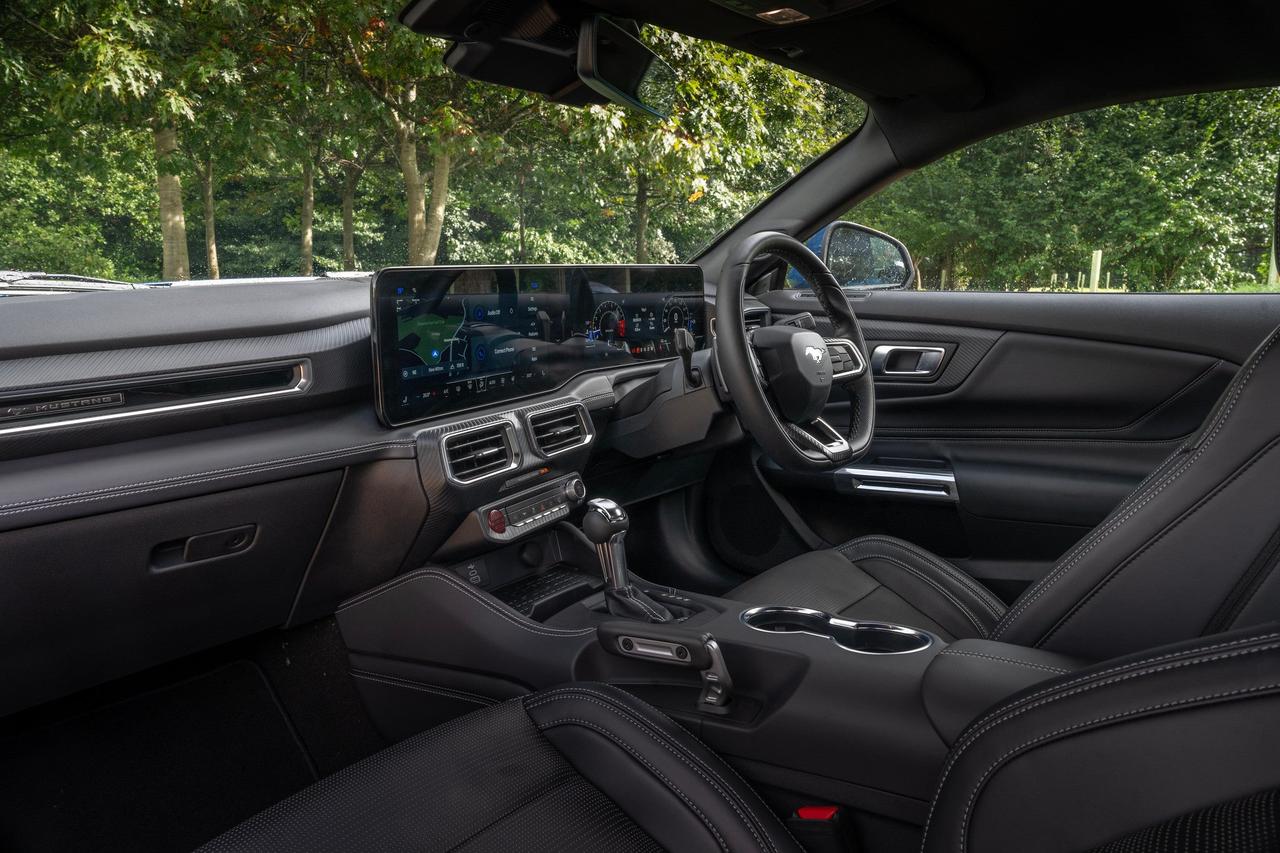
Swing open the Mustang's weighty and sizeable doors (be careful where you park in multistoreys…) and you sit low with your feet stretched out in front and slightly below you, and while the optional Recaro bucket seats may lose the standard seats' ventilation feature, they hug you nicely without being a pain to get in and out of, and larger body types will get along with them just fine. It's a shame they're only electrically adjustable front-and-back, with a manual lever to adjust the recline. The handbrake is now electronic, with a 'real' looking lever that activates or deactivates it… but you needn't touch the lever given the car automatically applies and releases the handbrake. You only need use the lever for the drift brake mode to lock the rear wheels and start a slide. Not a sensible car, this.
A heated steering wheel is standard (although the heating wires were already showing underneath the leather in our Dark Horse test car), and it's packed with physical buttons for the radar cruise control, driving modes, radio volume and station as well as a button to adjust the effort required to turn the steering wheel.
Behind the wheel is a 12-inch digital dashboard. The old Mustang had digital dials, but they weren't anywhere near as clear or glossy as this latest screen. The layout is eminently customisable (or can change depending on driving mode), and if you dive through some menus you can bring up speedo and rev-counter dials that mimic a couple of historic Mustangs, including a classic '67-'68, a late 1980s Foxbody or a turn of the millennium SVT Cobra.

If you thought the Mustang's driver's display was huge, wait until you see the 13-inch digital behemoth masquerading as the infotainment screen. It's big enough that reaching its left-most extremities is a bit of a reach when driving, and it's a shame that you need to use it to adjust the temperature – the only physical knob is for the stereo volume.

Still, the screen is sharp and mostly responsive, with only the occasional momentary 'loading' delay. Wireless Apple CarPlay and Android Auto are order of the day, and it's this central screen that you'll use to access the Mustang's Track Apps, such as the drift handbrake, launch control, tyre-shredding line-lock and more – all of which are far more intuitive and better explained than in the old car if you fancy some private-track hoonery.
Standard equipment on all UK Mustangs includes a 12-speaker Bang & Olufsen sound system complete with subwoofer mounted on the right-hand side of the boot. You also get a surprisingly clear reversing camera, front and rear parking sensors, as well as keyless entry and ignition.
Practicality
Sure, the Mustang's a bit of a land yacht at 4.8 metres long, and yes – most of that is bonnet and engine. But there's still a reasonable amount of practicality to be found.
There's plenty of storage up front, with roomy door bins for drinks, a full-width glovebox (no half-arsed Stellantis right-hand-drive conversion here), plus a pair of cupholders, a wireless phone charger and a deep box under the centre armrest, which also contains a 12-volt socket. There's a USB-A and a USB-C by the gearknob.

Back-seat space is tight for adults, but shorter friends might fit there if the front passenger and driver are happy to slide their seats forward. We easily fit our four- and six-year-old test subjects back there on booster seats, and there's a pair of Isofix points in the depths of the seats. Be aware that the Mustang is strictly a four-seater car – there's no middle seat, just a cushioned armrest-type area.

Boot space is useful at 381 litres, and the load bay stretches far into the bowels of the car. Sadly the opening itself is quite narrow, so getting a large suitcase in won't be easy. Load it up with soft bags, however, and you're set for a two-person roadtrip with acres of room for souvenir wine. For reference, a BMW M2 has 390 litres of space, and its opening is much squarer.
Engines and performance

The Ford Mustang is now only available (in the UK) with Ford's excellent 5.0-litre 'Coyote' V8. We say excellent – it does an outstanding job of turning lots of petrol into noise and low-down torque, propelling you at the horizon rapidly no matter where you are in the revs. It whips quickly to its 7,500rpm redline, and it sounds incredible no matter where in its arc the rev-counter needle sits. At idle it rocks the car gently with an off-beat burble that's a real pleasure for fans of American automotive icons.
Ford knows that noise is a big reason people buy Mustangs, and there are various settings for the exhaust. There's a quiet mode for not annoying neighbours on a cold winter morning, then there's a track mode for making sure absolutely everyone on the estate knows you've bought a Mustang. Listening to the Coyote crescendo while the Dark Horse's 3D-printed titanium gearknob fizzes in your left hand is one of motoring's most memorable feelings. Just try not to notice how quickly the gearknob picks up scratches from wedding rings and so on.

Performance feels strong, despite on-paper 0-62mph times ranging from 4.4 seconds for the 10-speed automatic gearbox up to 5.2 for the manual. Get the manual if at all possible, simply because the 10-speed shuffles ratios unecessarily and the manual is a delight to use, especially the Dark Horse's Tremec box with its shorter shift action and closer gear ratios than in the regular GT.
Perhaps the only disappointment is that UK Mustangs get about 453hp and 540Nm of torque – some 50hp less than US-market cars. You can blame emissions regulations for that one. Still, we doubt you'd be disappointed with the V8's punch. Top speed for all models is pegged at 155mph.
We saw fuel economy of 16mpg in 100 miles of mixed urban and country-road driving, but cruise in sixth with the revs well below 2,000rpm and you'll see closer to 25mpg, or even 30 if you've a following wind.
Driving and comfort

Ford's tweaked the Mustang's suspension for this latest version to improve the reassurance you get mid-corner, and it's worked to a degree. In our Dark Horse test car with its upgraded Magneride adaptive dampers, we felt a tad more connection to the road than in the previous Mustang. But regardless of whether we had the suspension in its softest or firmest setting, there's always a sense that the Mustang's 1.8-tonne mass is fighting with the road rather than flowing with it (see: Porsche 718 Cayman, BMW M2). On a long cruise, the Mustang's ride is comfortable enough, with only sharp cracks in the road unsettling the ride – and we found the Dark Horse would occasionally ground-out on a bumpy B-road in places no other car has ever done so.
The result of the Mustang's slightly wayward mass is that you're never entirely sure what the back or front tyres are doing, and under hard acceleration you're never confident when the rear tyres are going to break sideways. And they do – even with the traction control on, we experienced a few eyebrow-raising back-end slides just shifting from first to second gear in a straight line. The Mustang's loosey-goosey reputation remains intact, and we'll leave you to decide if that's a good thing or not. We'd personally prefer greater connection to the road for more cornering confidence.
Good thing then, that the steering rack is a bit faster than before, meaning that it'll respond more quickly to your inputs. Especially useful exiting junctions in the wet… or dry.

One of the benefits of the new infotainment system is that it makes it very easy to create a custom driving mode. Simply pick one of the pre-existing modes (Normal, Sport, Track) and you can create your own based on it. This means you can have a loud exhaust, sporty steering and accelerator response, but with the softest suspension setup.
The Dark Horse model's Torsen limited-slip differential does help the rear tyres seek out traction on corner exit, and it's satisfying feeling the tyres find grip before you bravely step on the accelerator as early as you dare before the next straight opens up.
Naturally the Mustang has a traction-control off button, which is only really useful for destroying the rear tyres and feeling the chassis move about. Save it for a private race track – with the system switched off you'll see a mirror full of tyre smoke even if you pull away reasonably gently…
Final word goes to the brakes. UK Mustangs get Brembo calipers as standard, and they're excellent, hauling the Mustang down from high speeds not just with brutal efficiency, but with real feel through the pedal and smooth modulation as you come off them for a corner.








































